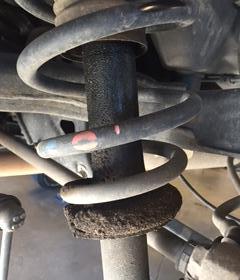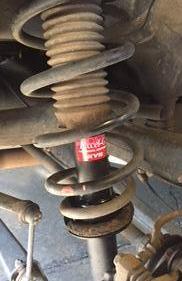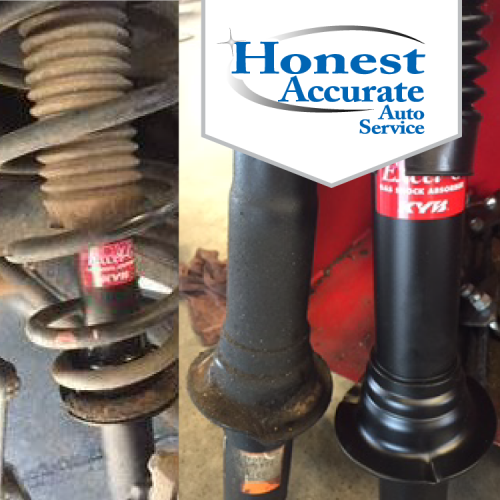5 Things You Need to Know About Shocks and Struts

1. Shocks and Struts Are Not Just for a Smoother Ride
There’s no doubt that one of the best benefits of shocks and struts is the comfort they provide for your ride. However, that’s really just a benefit of their ultimate function: to protect the structural integrity of your vehicle.
There are differences between shocks and struts despite their similar functions. A “shock” is a shock absorber and spring that sits behind the wheel of your car. This combo keeps the car from bobbing and bouncing while you drive, and when you hit bumps or encounter other obstacles in the road. Your shocks help you handle your vehicle and maintain control while in motion. As part of your suspension system, shocks keep your vehicle in your control.
Struts have the same purpose but perform differently. Struts are also a shock absorber and spring combo that perform in a single unit and attach to the wheel. Struts are a structural part of the car that keep the wheel in its proper position and help your vehicle weather rough roads, as well as braking and steering.
Both help your vehicle stay safer on the road and protect the overall integrity of your vehicle. They take the smacks, bumps and bangs our cars encounter even with safe driving and convert them to harmless energy instead of letting every joint, bolt and operating system suffer blow after blow. That’s why shock and strut replacement costs are worth your money. They save you way more on wear and tear and potential catastrophe.
2. All Vehicles Do Not Have the Same Shock and Strut Configuration

3. Shocks and Struts Should be Inspected every 12,000 Miles and Replaced Every 50,000 Miles
One of the most difficult challenges about driving a vehicle with shocks and struts is knowing when they need repair or replacement. Your car does not have a dashboard light or dipstick to tell you the front struts or rear shocks need servicing.
It’s also not easy to detect damage simply by examining the wheels. The rear strut housing, for example, can hide worn parts or make it appear your vehicle is fine. In fact, if you can easily see something is wrong, you’re probably already at the mechanic right now (or Googling articles like this to try to figure out what’s wrong).
Speaking of mechanics, that’s who should be inspecting your vehicle every 12,000 miles. Mechanics have the skill set to diagnose any potential problems in your vehicle, especially those in hidden systems. Your mechanic can also build a history for your vehicle that tracks the condition of your shocks and struts over time. Think of it like a doctor monitoring a minor health condition over the years to make sure it doesn’t get worse.
As for replacement, we get the reluctance many drivers feel. Replacement at 50,000 miles can feel like an overreaction. After all, if the vehicle is running fine, why worry about a non-issue? We can start by pointing to our first need-to-know and noting that the cost to repair shocks and struts — and other damage caused by their deterioration — can be quite expensive. Vehicle manufacturers recommend replacement at 50,000 miles because that’s when shocks and struts really begin to show the wear and tear caused by driving. That’s a full five years of operation for the average driver. If you’re scheduling regular inspections, your mechanic may even tell you that you can go a bit longer. That’s always nice news to share with a customer!
4. Where You Live and How You Drive Both Affect Your Suspension System

Drivers in areas with high humidity should be sure to stick with consistent inspections. The same is also true for drivers who put a lot of mileage on their vehicles, drive aggressively or take their vehicles in places they probably shouldn’t. We know that Rampart Range Road and Gold Camp are super awesome routes for exploring the Pikes Peak region, but they are also a nightmare scenario for the average vehicle. Take care to note where you live and how you drive (be honest) when creating a maintenance plan for your suspension system.
5. There Are Some Indicators that Can Tell You if Your Struts and Shocks Need Replacement
Do you think you might need a shock and strut replacement? The quickest way to find out is to bring your car in for an inspection. If it has been 12,000 miles since your last one, bring it on in. If it’s been 50,000 miles, definitely schedule an appointment with a mechanic. Remember, you can’t detect problems on your own in this system unless it’s already damaged enough to be obvious. Here are some of those obvious indicators that it’s time to replace your shocks and struts.
- Your car feels like it’s bouncing or riding waves when you are driving on the highway. Even a slight bounce can signal an issue.
- You feel like you’re riding with the Duke brothers when you take a turn. The sharper the turn, the more dramatic the “tipping” feeling your vehicle will have.
- Your front end dips and dives when you brake. If you feel like a bat swooping for insects at every stop sign, call your mechanic.
- Your tires are wearing out faster than usual or the wear on the tread is inconsistent with normal issues like alignment or failure to rotate.
- Leaks around the shocks and struts.
- Hitting a pothole or taking a speed bump too fast feels like getting into an accident or destroying your car.
If you’ve noticed any of these problems, get your car into the shop to be looked at by a professional.
Don’t Delay Inspections or Replacement of Shocks and Struts
As you can see from these quick facts, shocks and struts are critical to protecting your car from serious (and expensive) damage. While no car owner is excited about the prospect of replacement, delaying the service can be extremely expensive — and may even cost you your car. Get your car in for an inspection today to get ahead of any potential problems.



